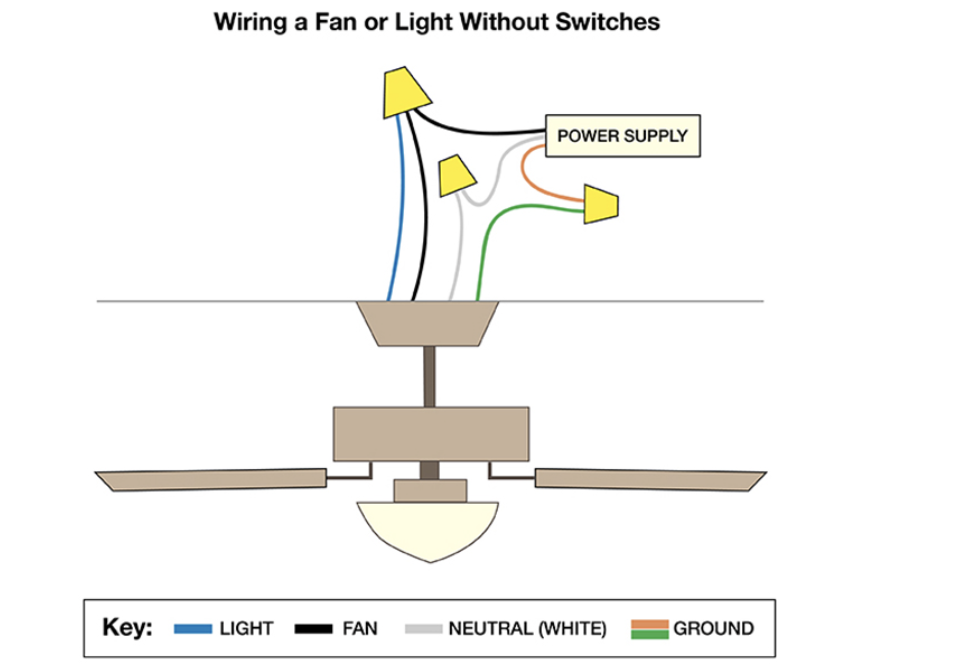Find more about Red wire ceiling fan.
Imagine a hot summer day with the sun pounding down on your house with relentless heat. In anticipation of enjoying the soothing breeze that your dependable red wire ceiling fan promises to provide, you reach for the remote control.
But hold on, what if you can’t make sense of the mysterious red line hanging from your ceiling?
Few things in the world of electrical and home improvement installations may be as confusing as the red wire in a ceiling fan.
Also read>>>>Ceiling Fan Clicking.
The unsung hero who can turn your home into a haven of comfort is silently tucked away behind a web of black, white, and green wires.
Understanding the red wire in ceiling fans is crucial, regardless of your level of DIY experience or your level of familiarity with house maintenance.

It is the secret to releasing your cooling partner’s full power and guaranteeing that your electrical system runs without a hitch.
In this post, we travel deep within the home to examine the intricate workings of the red wire in the ceiling fan. We’ll solve the riddle around this red conductor, explaining what it does and how to install it successfully.
You’ll learn about the various wiring setups, solutions, and safety precautions required to overcome any difficulties that may emerge when working with the red wire of your ceiling fan.
Therefore, join us as we shed light on the fascinating world of the red wire ceiling fan, whether you’re preparing to set out on a ceiling fan installation expedition or simply looking to improve your understanding of household wiring.
Discover the strength, ease, and comfort it holds at your disposal, and you’ll never again be left scorching in the summertime while searching for that elusive red wire above.
Let’s jump in and utilize your cooling partner to the most extent possible.
Explanation of The Red Wire.
Consider the ceiling fan with the red wire as the conductor of your cozy symphony. The electrical tapestry’s bright thread is what ties the enchantment of your ceiling fan’s operation together.
But what is the red wire precisely, and why is it so significant?
The Red Wire
The red wire is your fan’s secret ingredient in the visually appealing realm of electrical wiring. It is a conduit for potential and a wire of strength. It is tucked away with its friends, the black, white, and green wires, but it is crucial to coordinating the operation of your ceiling fan.
Also read>>>>Ceiling Fans Without Lights.
Role red wire in ceiling fan.
The red wire actively participates in the performance rather than just being a decorative accent. The wire configuration affects its principal function, although its importance is constant.
The red wire frequently links to the fan’s motor in a dual-switch configuration, allowing speed control.
You may control the speed of your refreshing wind by turning this knob, whether you want a soft zephyr on a warm evening or a fierce gale to beat the oppressive heat.
The red wire can be used as a hot wire or a secondary hot wire in single-switch arrangements, offering an extra source of power for accessories like a remote control receiver or a light kit for a ceiling fan.
This adaptability is demonstrated by the red wire’s versatility, which makes it a crucial component in designing your red wire ceiling fan to meet your needs.
Significance in the Fan’s Symphony
The red wire is necessary for the proper operation of your ceiling fan. It’s the sound that creates harmony in your home and keeps you comfortable all year long.
By circulating warm air in the winter or generating a cool breeze in the sweltering summer, the red wire ceiling fan turns a drab space into a haven of leisure.
As we delve further into the realm of red wire in the ceiling fans, keep in mind that this red thread is a conduit to a more cozy and delightful home atmosphere, not just an electrical component.
Your assurance of a personalized cooling experience from its presence transforms your place from ordinary to spectacular.
Hold on to this bright thread as we continue our investigation to learn how to install, repair, and utilize your favorite red wire ceiling fan to the fullest.
Wiring Basics of a Red Wire Ceiling Fan.
It’s time to introduce the supporting cast, the other wires that support the flamboyant red wire in our red wire ceiling fan and enable this performance.
Understanding these fundamental wiring concepts is like to understanding the notes in a symphony; each wire has a specific role to perform and harmonizes to provide the ideal soothing harmony.
The Key Players:
In our electrical ensemble, we have four main actors:
- The Red Wire: We’re already acquainted with our star performer, the red wire. It controls the speed and often powers additional features in your ceiling fan, turning your room into a comfortable haven.
- The Black Wire: Think of this wire as the main conductor, the one responsible for delivering power to your ceiling fan. It’s the backbone of the operation, ensuring your fan gets the juice it needs to spin and work its magic.
- The White Wire: Our dependable white wire is the neutral player. It’s the calm counterpart to the energetic black wire, providing the path for the electrical current to return after doing its job. Without the white wire, our electrical symphony would be incomplete and chaotic.
- The Green Wire: Picture the green wire as the safety net. It’s your grounding wire, designed to dissipate any excess electrical energy harmlessly into the earth, keeping you safe from electrical shocks.
Their Function.
Now, let’s see how these wires dance together in the grand performance of your red wire the ceiling fan:
- The red wire takes center stage, connecting to the fan’s motor, orchestrating the speed and sometimes powering added functionalities.
- Our black wire, the powerhouse, links to the fan’s primary motor circuit, delivering electrical energy to set the blades in motion.
- The white wire dutifully completes the circuit, ensuring that the electrical current flows smoothly, allowing your fan to spin and deliver cool, refreshing air.
- Meanwhile, the green wire stays grounded, ready to protect you and your home from any electrical surges.
Explore more on Ventilation for Ceiling.
Creating the Symphony:
As a maestro, visualize the red wire ceiling fan conducting this network of wires to produce a masterpiece of comfort.
Together, they make your space a tranquil retreat while protecting your security and the proper operation of your fan.
Remember that these wires, including our vivacious red wire, are the notes that make up the tranquil song of your home’s cooling system as we continue our exploration of ceiling fan wiring.
Your red wire ceiling fan is an important addition to any room since their harmony ensures your comfort and safety.
Keep reading as we examine the nuances of wiring layouts, installation procedures, and troubleshooting advice to maximize the operation of your ceiling fan.
Installation Steps.
You’ve met the red wire ceiling fan and learned more about how it operates. It’s time to bring beautiful artwork to life in your house right now.
Although installing a ceiling fan could appear difficult, have no fear! The installation will be successful if you follow our step-by-step instructions, leaving your room cool and comfortable.
Step 1: Gather Your Tools and Materials
Before you embark on your red wire ceiling fan installation journey, make sure you have the following tools and materials at your disposal:
- Screwdrivers (Phillips and flathead)
- Wire stripper and pliers
- Voltage tester
- Circuit breaker
- Ladder
- Ceiling fan installation kit (provided with the fan)
- Electrical tape
- Wire connectors
- Wire nuts
- Red wire ceiling fan and its components
Step 2: Turn Off the Power.
Safety first! Head to your electrical panel and turn off the power to the room where you’ll be installing the fan. Double-check using a voltage tester to ensure there’s no live current.
Step 3: Prepare the Ceiling.
If you’re replacing an existing light fixture with your red wire ceiling fan, remove the old fixture carefully. If it’s a new installation, follow the manufacturer’s instructions to install the ceiling fan mounting bracket.
Step 4: Assemble the Fan.
Refer to the fan’s instruction manual to assemble the fan components, including the blades, downrod, and any light kit. Make sure to follow the provided guidelines precisely.
Step 5: Mount the Fan.
Attach the ceiling fan to the mounting bracket securely. Ensure that the wires are properly threaded through the downrod.
Step 6: Wiring Configuration
Now, the spotlight turns to our red wire ceiling fan. Depending on your wiring setup, you may connect the red wire to different parts of the fan. Follow these common configurations:
- Dual-Switch Setup: Connect the red wire to the motor’s lead wire. This controls the fan’s speed. Connect the black and white wires to their respective counterparts in the ceiling box. The green wire is the ground and should be connected to the ceiling box or a grounding wire if available.
- Single-Switch Setup: Connect the red wire to the hot wire (usually black or blue) of the ceiling fan. The white wire connects to the white wire, and the green wire to the grounding system.
Step 7: Secure the Wiring.
Use wire nuts and electrical tape to secure the connections. Ensure that there are no exposed wires, and everything is snug and safe.
Step 8: Attach Blades and Light Kit.
Follow the manufacturer’s instructions to attach the fan blades and any light kit.
Step 9: Test the Fan.
Before re-energizing the circuit, double-check all connections, and ensure the fan blades can move freely. Then, turn the power back on and test the fan and light to make sure they function correctly.
Step 10: Enjoy Your Red Wire Ceiling Fan.
With the red wire ceiling fan correctly installed, bask in the comfort of your transformed living space. The fan will provide the cooling relief you desire while adding a touch of elegance to your home decor.
Trouble Shooting a Red Wire Ceiling Fan.
Even in the most harmonious of symphonies, a discordant note might occasionally appear. Even if it is a comforting work of art, the red wire ceiling fan is not an exception.
But don’t worry; we’re here to assist you in troubleshooting frequent problems so that your cooling symphony goes off without a hitch.
Issue 1: Red Wire Not Functioning
Symphony Interrupted: The red wire in your ceiling fan seems to have lost its rhythm.
Troubleshooting Steps:
- Check the Wiring: Examine the wiring connections involving the red wire. Ensure it’s securely connected to the appropriate terminal or lead wire, depending on your wiring configuration.
- Switch Position: In a dual-switch setup, make sure the wall switch for the fan is turned on. In a single-switch configuration, verify that the switch is providing power to the fan.
- Bulb or Light Kit: If the red wire powers the fan’s light, check the light kit or bulb for any issues. Replace the bulb or troubleshoot the light kit as needed.
- Circuit Breaker: Inspect the circuit breaker to ensure it hasn’t tripped. If it has, reset it and see if the red wire ceiling fan functions correctly.
- Voltage Tester: Use a voltage tester to check if there’s power reaching the red wire. If not, there might be an issue with the electrical supply.
Issue 2: Fan Not Operating Properly.
Symphony Out of Tune: Your red wire ceiling fan isn’t delivering the expected breeze.
Troubleshooting Steps:
- Blades and Downrod: Ensure that the fan blades and downrod are securely attached and not obstructed by any objects or debris.
- Balance and Wobble: If the fan wobbles excessively, it might not operate efficiently. Use a balancing kit to correct any balance issues.
- Motor Lubrication: Some ceiling fans require periodic motor lubrication. Check the manufacturer’s guidelines and lubricate the motor if necessary.
- Switches and Controls: Confirm that the fan’s switches and remote control (if applicable) are set to the desired settings. Sometimes, a simple adjustment can solve performance issues.
Issue 3: Unusual Noises.
Troubleshooting Steps:
- Tighten Screws: Loose screws in the fan or mounting bracket can cause rattling noises. Check and tighten all screws, including those on the blades and motor housing.
- Balancing: As mentioned earlier, an imbalanced fan can generate unusual noises. Ensure the fan is balanced correctly.
- Motor Issues: Grinding or squeaking noises may indicate motor problems. Contact the manufacturer or a professional technician for motor inspection and maintenanc
- Remote Control Batteries: If your ceiling fan is controlled by a remote, replace the batteries to rule out signal interference or erratic behaviour .
- Ceiling Mounting: Ensure the ceiling fan is securely mounted to the ceiling to prevent vibrations that might lead to noise.
Wiring Regulations and Codes of a Red Wire Ceiling Fan.
We must take a minute to underline the significance of following electrical standards and regulations as we continue to delve into the fascinating world of red wire ceiling fans.
Following electrical standards ensures that the installation and functioning of your fan are both secure and harmonious, just as a symphony follows a score to produce a masterpiece.
Also read>>>ventilation fans.
The Art of Compliance
When red wire in the ceiling fan symphony is being conducted by the electrical codes and regulations.
They create an environment where safety and performance coexist by making sure that every note, or in this case, every wire, is perfectly in tune.
Why Adherence Matters
- Safety First: Electrical codes exist to protect you, your home, and your loved ones. A failure to follow these guidelines can result in electrical hazards, including fires, shocks, or damage to your ceiling fan.
- Avoiding Legal Issues: Non-compliance with local electrical codes can lead to legal repercussions, such as fines or invalidated insurance claims in the event of an electrical incident.
- Warranty Considerations: Many ceiling fan manufacturers require that installations comply with electrical codes to maintain the warranty. Failing to do so could void your warranty.
Red Wire and Compliance.
A crucial part of your electrical system is the red wire in your ceiling fan. It’s crucial to confirm that it is connected properly in accordance with both the manufacturer’s instructions and your local electrical codes.
For safe and effective operation, it is crucial to follow the recommended wiring configuration, whether it regulates the fan’s speed or powers extra functions.
Safety Tips:
- Research Local Codes: Familiarize yourself with the electrical codes and regulations specific to your area. These may vary from place to place, so staying informed is crucial.
- Follow the Manufacturer’s Instructions: The manufacturer provides guidelines for proper installation and wiring. Always follow these instructions meticulously.
- Consult a Professional: If you’re unsure about any aspect of the installation, don’t hesitate to consult a licensed electrician. They have the expertise to ensure compliance and safety.
- Inspect Existing Wiring: If you’re replacing an old fan or making changes to your electrical system, inspect the existing wiring to ensure it meets current codes.
- Use Quality Materials: Invest in high-quality wiring and components to minimize the risk of electrical issues down the road.
Also read>>>>broan exhaust fan.
Frequently Asked Questions (FAQs).
1. What is the role of the red wire in a ceiling fan?
- The red wire in a ceiling fan plays a pivotal role in controlling the fan’s speed and sometimes powering additional features, transforming your space into a haven of comfort.
2. How do I properly install a red wire ceiling fan?
- Follow these steps: First, gather the necessary tools and materials. Turn off the power, prepare the ceiling, assemble the fan, mount it securely, configure the wiring, attach blades and light kit, test the fan, and finally, enjoy the cool breeze.
3. What should I do if the red wire in my ceiling fan is not working?
- Check the wiring connections, ensure the wall switch is on (for dual-switch setups), inspect the circuit breaker, use a voltage tester to confirm power, and examine the bulb or light kit (if applicable) for issues.
4. My ceiling fan is making strange noises. How can I fix it?
- If your fan is making unusual noises, try tightening screws, ensuring proper balance, lubricating the motor (if required), checking switches and controls, and examining the ceiling mounting for vibrations.
5. Why is it crucial to follow electrical codes and regulations when installing a ceiling fan?
- Adhering to electrical codes ensures your safety, protects your home from potential hazards, prevents legal issues and warranty voiding, and maintains a harmonious electrical environment in your home.
6. Can I use the red wire in my ceiling fan for something other than controlling the fan speed?
- Yes, in single-switch setups, the red wire can be used to power additional features like a ceiling fan light kit or a remote control receiver, providing flexibility in customizing your fan.
7. Is it necessary to consult a professional electrician when installing a red wire the ceiling fan?
- If you have any doubts or concerns about the installation, it’s highly recommended to consult a licensed electrician. They can ensure compliance with electrical codes and regulations, enhancing safety and performance.
Conclusion.
This is a representation of both elegance and practicality in the world of home comfort and ease.
This exploration of its inner workings—from the mysterious red wire to installation and troubleshooting—has revealed the techniques for designing a peaceful living environment.
Although our cooling symphony’s tempo is controlled by the red wire, it is important to keep in mind that following electrical codes guarantees both performance and safety.
Let your future efforts in keeping a secure, effective, and fashionable home environment—where the red wire ceiling fan will continue to bring comfort and charm—be guided by the lessons you’ve learned as we come to a conclusion.









